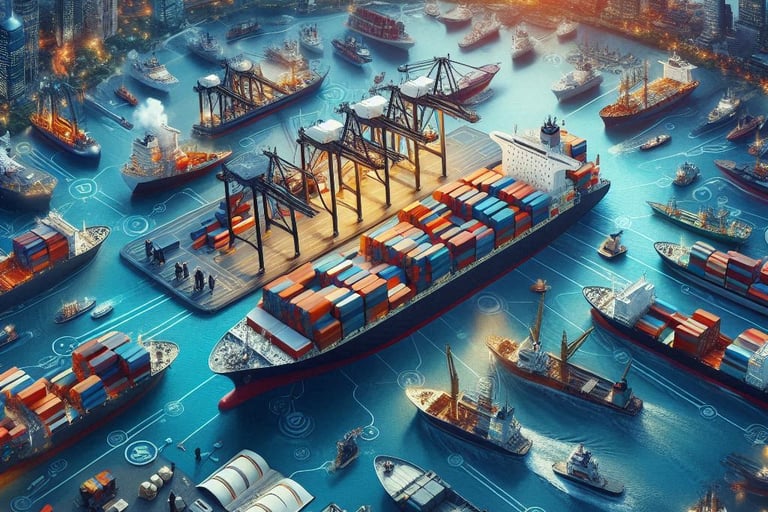Ports & Terminals: The Gateways of Global Trade
This page explores the vital role of ports and terminals in facilitating international trade. We'll delve into their purpose, core functions, operational aspects, a glimpse into the future of port development, and showcase some of the top global port operators.
What Are Ports & Terminals?
Ports and terminals are not the same, but they work hand-in-hand. Here's a breakdown:
Ports: Ports are designated areas along a coastline or waterway equipped to handle cargo movement. They serve as gateways for international trade, providing infrastructure for the loading, unloading, and storage of goods.
Terminals: Terminals are specialized facilities within a port designed to handle specific cargo types. They are essentially processing centers within the port, equipped for efficient cargo handling and movement between land and sea.


Types of Terminals:
Container Terminals: Handle the vast majority of cargo transported by sea today, designed for efficient handling of standardized shipping containers.
General Cargo Terminals: Deal with a variety of non-containerized cargo like break-bulk (bags, drums, etc.) and project cargo (oversize items).
Bulk Cargo Terminals: Dedicated to bulk commodities like grain, coal, or oil, often featuring specialized equipment for loading and unloading.
Passenger Terminals: Handle passenger traffic for ferries, cruise ships, or other passenger vessels.
What Do Ports & Terminals Do?
Ports and terminals play a crucial role in the global supply chain by:
Providing Infrastructure: They offer essential infrastructure for the safe and efficient transfer of cargo between ships, trucks, trains, and barges.
Cargo Handling: They facilitate the loading, unloading, storage, and sorting of cargo using specialized equipment and personnel.
Customs Clearance: Ports work with customs authorities to ensure proper documentation and inspection of goods entering or exiting a country.
Value-Added Services: Some ports offer additional services like container packing, fumigation, and bonded storage.
How Do Ports & Terminals Operate?
Port operations involve a complex interplay between various stakeholders:
Port Authorities: Government agencies or private companies responsible for managing and developing port infrastructure.
Terminal Operators: Companies specializing in operating specific terminals within a port, responsible for efficient cargo handling.
Shipping Lines: Companies that operate fleets of ships and utilize ports to move cargo.
Freight Forwarders: Act as intermediaries, handling logistics, documentation, and customs clearance for shippers.
Stevedores: Companies that provide labor and expertise for loading and unloading cargo ships at ports.
The Future View: A Look Ahead for Ports & Terminals
The future of ports and terminals is shaped by several trends:
Automation and Technology: Increased use of automation, robotics, and AI for faster and more efficient cargo handling.
Sustainability Focus: Emphasis on green practices like using cleaner fuels and shore power for ships while docked.
Evolving Trade Patterns: Adaptation to changing global trade dynamics and potential shifts in major shipping routes.
Smart Port Development: Integration of technology to optimize port operations, improve information flow, and enhance security.
Top Global Port Operators
Several companies operate and manage major ports and terminals worldwide. Here are some prominent players (in no particular order):
DP World (Dubai): A leading global logistics provider with a significant portfolio of port terminals worldwide.
Singapore Ports (Singapore): A major port operator known for its efficiency and advanced technology integration.
Rotterdam Port Authority (Netherlands): One of the busiest ports in Europe, known for its focus on bulk cargo and container shipping.
Hong Kong Port Authority (China): A major container port in Asia, strategically located for international trade.
Shanghai International Port (Group) Co., Ltd. (China): One of the busiest container ports globally.
COSCO Shipping Ports (China): A major Chinese state-owned port operator with a global network of terminals.
PSA International (Singapore): A leading global port operator with a presence in over 50 countries.
APM Terminals (Netherlands): A subsidiary of A.P. Moller-Maersk, operating a global network of container terminals.
International Container Terminal Services Inc. (Philippines): A prominent port operator in the Asia-Pacific region.
Dubai Ports World (United Arab Emirates): A subsidiary of DP World focusing on port management and related services.
Remember, this is not an exhaustive list. Many other regional and national port authorities play significant roles in global trade.
Conclusion: Ports and terminals are the critical arteries of global trade, enabling the seamless movement of goods across the world.
By understanding their functions, operations, and future development, you gain valuable insights into the critical role they play in the global supply chain.


